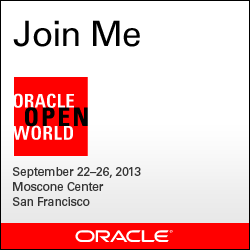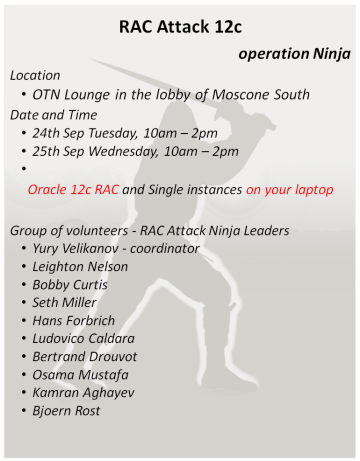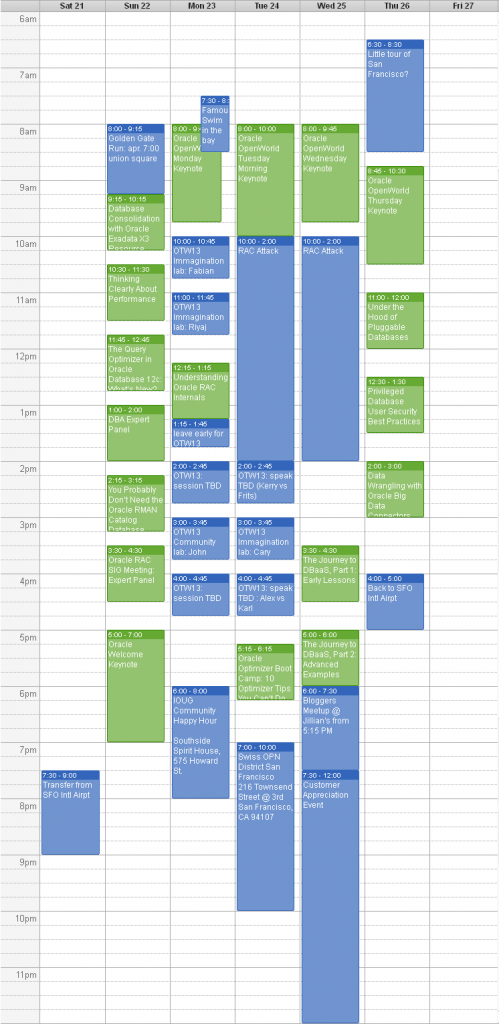 I’m back at work now, safely, after the week in San Francisco.
I’m back at work now, safely, after the week in San Francisco.
It’s time to sit down, and try to pull out some thought about what I’ve experienced and done.
I’ll start from the new announcements, what is most important for most people, and leave my personal experience for my next post.
In-memory Database Option
Oracle has announced the In-Memory option for the Oracle Database. This feature will store the data simultaneously in traditional row-based and into a new in-memory columnar format, to serve optimally both analytics and OLTP workloads AT THE SAME TIME. Because column-based storage is redundant, it will work without logging mechanism, so the overhead will be minimal. The marketing message claims “ungodly speed”: 100x faster queries for analytics and 2x faster queries in OLTP environments.
By separating Analytics and OLTP with different storage formats, the indexes on the row-based version of the table can be reduced to make the transactions faster, getting the rid of the analytical indexes thank to the columnar format that is already optimized for that kind of workload. The activation of the option will be transparent to the applications.
How it will be activated?
|
1 2 3 |
inmemory_size = XXX GB alter table foo ... inmemory; |
Now my considerations:
- [evil] Will this option make your database faster than putting it on an actual Exadata?
- It will be an option, so it will cost extra-money on top of the Enterprise Edition
- [I guess] it will be released with 12cR2 because a such big change cannot be introduced simply with a patch set. So I think we’ll not see it before the end of 2014
- And, uh, Maria Colgan has given up the Product Management of the Cost Based Optimizer to become the Product Manager of the In-Memory option. Tom Kyte will take the ownership of the CBO.
M6-32 Big Memory Machine
I’ve paid much less attention for this new announcement. The new big super hyper machine engineered by Oracle will have:
- 1024 DIMMS
- 32TB of DRAM
- 12 cores per processors
- 96 threads per processor
This huge memory machine can be connected through InfiniBand to an Exadata to rely on its storage cells.
But it will cost 3M$, so it’s not really intended for SMBs or for the average DBA, that’s why I don’t care too much about it…
Oracle Database Backup, Logging, Recovery Appliance
Only 8 minutes in the keynote to introduce this appliance that is really hot, IMHO. This… oh my… let’s call it ODBLRA, is a backup appliance (based on the same HW of Exadata) capable of receiving the stream of redo logging over SQL*Net, the same way as it’s done with DataGuard, except that instead of having a standby database, you’ll have an appliance capable of storing all the redo stream of your entire DB farm and have a real-time backup of your transactions. That’s it: no transactions lost between two backup archives and no need to have hundreds of DataGuard setups or network filesystems as secondary destinations in order to make your redo stream safer.
I guess that it will host an engine RMAN-aware that can create incremental-updated backups, so that you can almost forget about full backups. You can leverage an existent tape infrastructure to offload the appliance if it starts getting full.
Your ODBLRA can also replicate your backups to an another appliance hosted on the Oracle Cloud: ODBLRAaaS! 🙂
To conclude, Oracle is pushing for bigger, dedicated, specialized SPARC machines instead of relying on commodity hardware…
Oracle Multi-tenant Self-Service Provisioning
There’s a new APEX application, now in BETA, that can be downloaded from the Oracle Multitenant Page that provides self-service provisioning of databases in a Multitenant architecture. It’s worth a try… if you plan to introduce the Multitenant option in your environment!
All products in the Cloud
Oracle now offers (as a preview) its Database, Middleware and Applications as a Service, in its public cloud. For a DBA can be of interest:
The Storage aaS, use Java & REST API (Openstack SWIFT) for block level access to the storage.
The Computing aaS allows you to scale the computing power to follow your computing needs.
The Database aaS is the standard, full-featured Oracle Database (in the cloud!) 11gR2 or 12c in all editions (SE, SE1, EE). You can choose five different sizes, up to 17cores and 256Gb of RAM, and choose 3 different formulas:
- Single Schema (3 sizes: 5, 20 or 50Gb, with prices from 175$/month to 2000$/month)
- Basic Database (user-managed, single-instance preconfigured databases only with a local EM)
- Managed Database (single-instance with managed backups & PITR, managed quarterly apply of critical parches)
- Premium Managed Database (fully managed RAC, with optional DG or Active DG, PDB and upgrades)
My considerations:
- Oracle releases this cloud offering with significant delay comparing to his competitors
- It’s still in preview and there’s no information about the billing schema. Depending on that, it can be more or less attractive.
- As for other cloud services, the performance will be acceptable only when putting all the stack into the same cloud (WebLogic, DB, etc.)
Oracle on Azure
Microsoft starts offering preconfigured Oracle platforms, Database and WebLogic, on Azure on both Linux and Windows systems. I haven’t seen the price list yet, but IMHO Azure has been around since longtime now, and it appears as a reliable and settled alternative comparing to Oracle Cloud. Nice move Microsoft, I think it deserves special attention.
Keynotes recordings
You can see the full keynote recordings here:
Oracle OpenWorld Keynote Highlights
Larry Ellison — Oracle OpenWorld Keynote 9-22-2013
Oracle OpenWorld General Session 2013: Database
Kurian and Fowler — Oracle OpenWorld Keynote 9-24-2013
Will these announcements change your life? Let me know…
…and stay tuned, I’ll come soon with a new post about the my “real” week at the Open World and why I’ve loved it.
Ludovico



